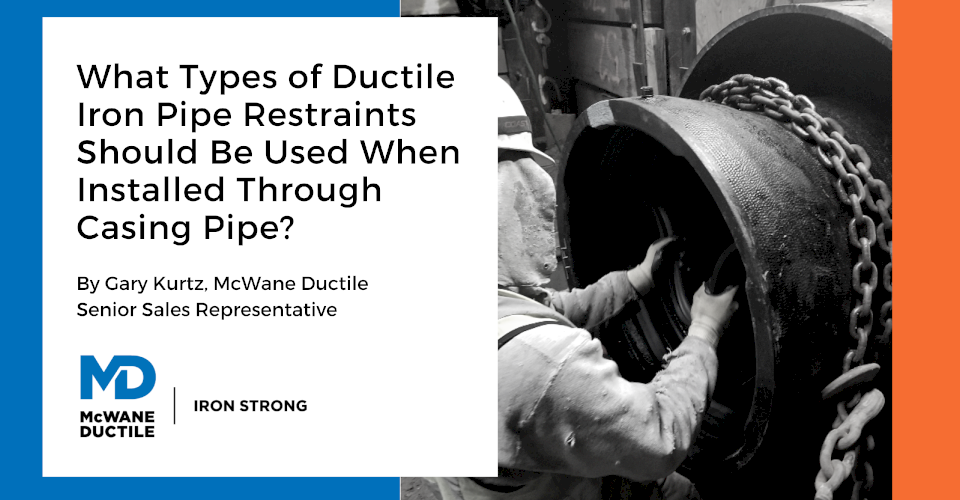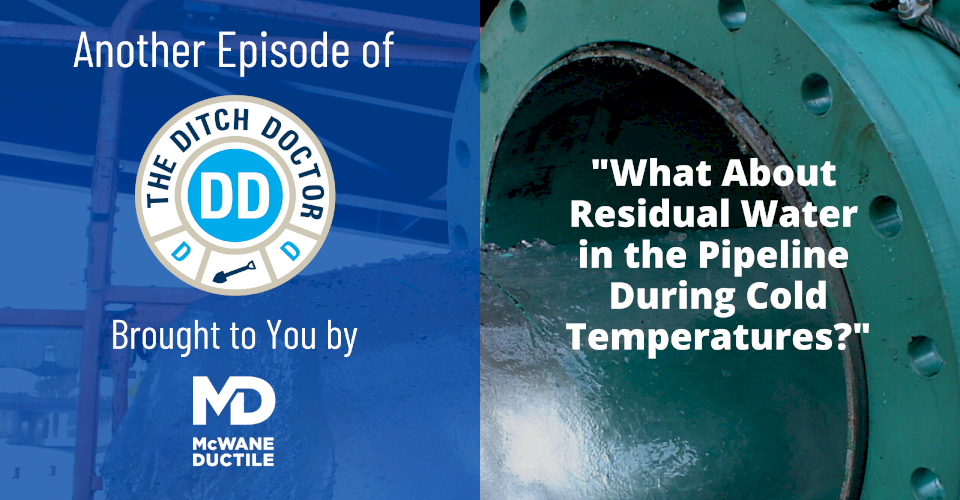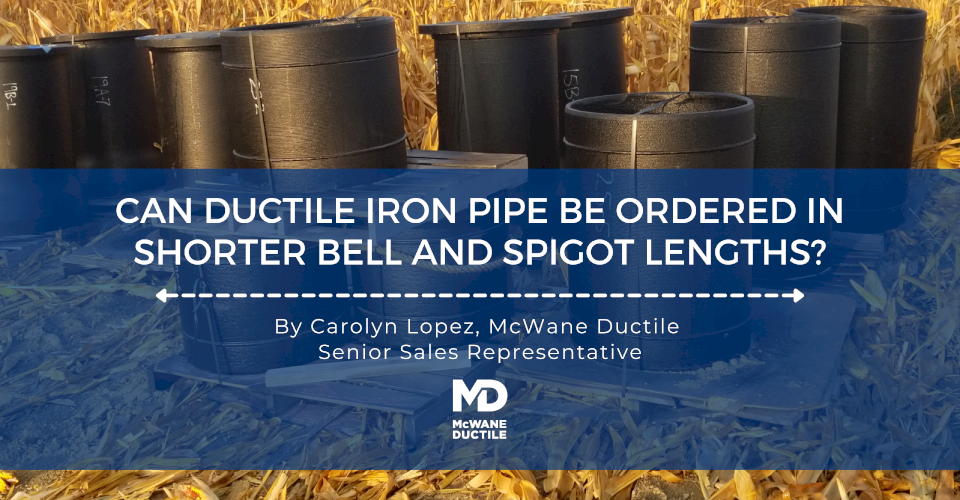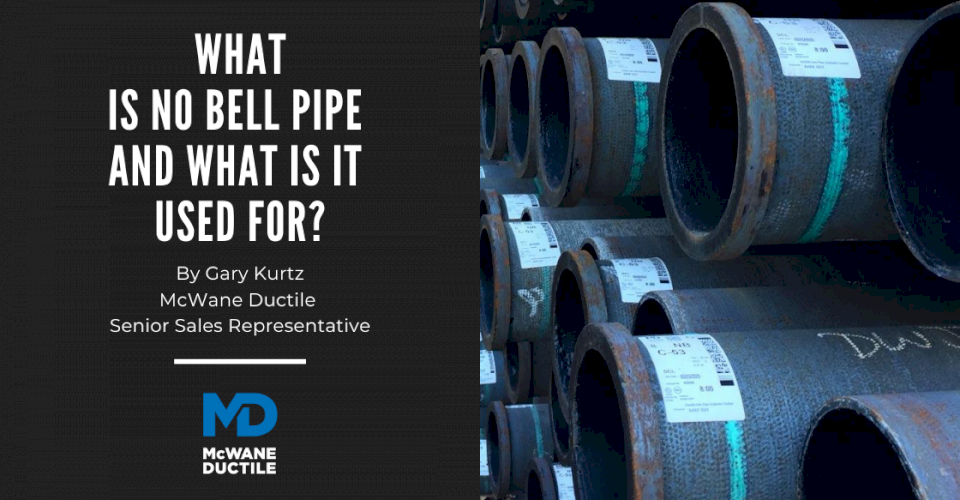-
What Are Common Installation Methods for Ball & Socket River Crossing Pipe and How is it Assembled?
05/14/2021 In Installation ProductsAs the name suggests, Ball & Socket River Crossing Pipe manufactured by McWane Ductile is a severe application Ductile iron pipe (DI pipe) product manufactured to meet the demanding requirements associated with crossing rivers, streams, and lakes. In this blog, we will discuss the various installation methods associated with Ball & Socket pipe and basic assembly instructions.
-
Ask the Ditch Doctor - Does the Direction of Ductile Iron Pipe Matter?
04/01/2021 In Installation ProductsHelp Me Ditch Doctor,
The inspector on this pipeline project came out here and just told us we are laying pipe in the wrong direction. He said the bells have to face the other direction like the plans show. He wants us to dig up the 1,000 feet of pipe we've already installed and reverse each pipe. Is he for real? Does it really matter?
-
What Types of Ductile Iron Pipe Restraints Should Be Used When Installed Through Casing Pipe?
03/12/2021 In Installation Products TechnicalAs a companion piece to the Iron Strong Blog entry, What Type of Ductile Iron Pipe Joint Is Right for You? by Scott Rhorick, this article takes a deeper dive into the specifics of installing restrained joint Ductile iron pipe (DI pipe) through a steel casing pipe. While many options are available industry-wide, this article concentrates on using TR Flex® or Sure Stop Gaskets in cased installations.
-
What Type of Ductile Iron Pipe Joint Is Right for You?
03/08/2021 In Installation Products TechnicalThere are a variety of Ductile iron pipe (DI pipe) joints on the market. These different types of joint designs can now allow for additional benefits for various applications. Joining pipe together is just as important as the pipe itself. It sounds like a simple procedure, but the environment in which the pipe is assembled is critical.
-
How to CAD Weld on Ductile Iron Pipe
02/18/2021 In Installation TechnicalThermite welding, often referred to as CAD welding, on Ductile iron pipe (DI pipe) and products is a common practice in our industry today. This welding technique of using heat from an exothermic reaction to produce coalescence between two metals is most often used to bond the Ductile iron joints for cathodic protection or for the opportunity to add a cathodic protection system at a later date. In this Iron Strong Blog, we will discuss when, why, and how to properly CAD weld on DI pipe.
-
Ask the Ditch Doctor - What About Residual Water in Cold Temps?
02/12/2021 In Installation TechnicalDear Ditch Doctor
We recently installed a 15,000-ft 12-inch diameter Ductile iron pipeline with several 6-inch branches off two hydrants. The average depth of cover is 4 feet. The city engineer has expressed a concern that residual groundwater might have entered the pipeline during our installation activities.
-
Can Ductile Iron Pipe Be Ordered in Shorter Bell and Spigot Lengths?
01/29/2021 In Installation Products TechnicalHave you ever wondered or asked if it is possible to order shorter lengths of bell and spigot Ductile iron pipe (DI pipe) for your waterworks project or sections within it? The answer is YES; we can help you with those shorter lengths of DI pipe for your project.
-
How Does Proper Bedding Allow a Pipe to “Sleep Well?"
01/22/2021 In Installation TechnicalDid you know the mattress industry is one of the oldest continuous industries in the world? The first mattresses were believed to have been manufactured in 37 BC in Persia. Today, more than 35 million mattresses are shipped world-wide to replace those that have been in service for an average of seven years. So, what does this have to do with Ductile iron pipe (DI pipe), you ask? This article will discuss how setting improper bedding in a pipe trench can cause sleepless nights for the water company and its crews due to pipe failures, seemingly always at night — as it is my experience that most large main breaks typically occur after dark!
-
V-Bio® Vs. Regular Black Polyethylene Encasement – What’s The Difference?
12/30/2020 In Installation TechnicalPolyethylene Encasement (Polywrap) was first used in 1958 and has successfully protected millions of feet of both cast and Ductile iron pipe (DI pipe). It has been the most popular method of corrosion control for DI pipe throughout the years. Today, it is the most widely used method of protecting DI pipe in corrosive environments.
-
What Is No Bell Pipe and What Is It Used For?
12/10/2020 In Installation Products TechnicalWhy do you make Ductile iron pipe with no bell? Who would use such pipe? What is it used for? All good questions from most people in our industry, unless you are a pipe fabricator.
Latest Posts
- Developing an Asset Management Plan for Your Future Utility or Engineering Organization 12/04/2025 In Comparisons Industry
- Can Joining Water Works Industry Organizations Help You Grow Professionally? 10/21/2025 In Careers WaterWorks
- How Does Ductile Iron Pipe Provide Proven Resilience to Seismic Events? 09/04/2025 In Products Resiliency Technical
- How to Secure Green Reserve Sustainability Incentives Using State Revolving Funding & Ductile Iron Pipe 07/29/2025 In Energy Products Technical















